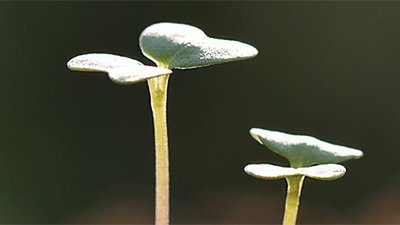Scientists Map Plant Protein Interactions
A cellular roadmap for the mustard plant reveals some secrets.
News Source
- ScienceDaily: “Largest-Ever Map of Plant Protein Interactions”
An international team involved in the Interactome Mapping Consortium has collaborated to map thousands of protein-protein interactions in Arabidopsis mustard plants and to correlate them with the genes that code for each protein. According to Joseph Ecker of the Salk Institute, “These data along with data from future ‘interactome’ mapping studies like this one should enable biologists to make agricultural plants more resistant to drought and diseases, more nutritious, and generally more useful to mankind.”
The team demonstrated a complex mechanism by which natural selection can influence the genome. They unveiled a way that plants increase their genetic diversity. And they were shocked to discover that pathogens attack the same complex targets in organisms even after “about a billion years of evolution.”
Proteins must work together for organisms to function properly. The researchers have identified 6,205 pairs of protein interactions for Arabidopsis, and they’ve only mapped two percent of the “interactome” so far. Plants engage in a lot of gene duplication. 1,900 of the interacting pairs of proteins appear associated with prior gene duplication. This process enables a plant to put the same protein to work in a lot of different places. “These gene duplication events apparently give plants some of the genetic versatility they need to stay adapted to shifting environments.”
The protein combinations which offer a plant the most survival advantages in its particular habitat will be naturally selected and passed on.
Correlation of those protein interactions with the genes which code for them can explain complex inheritance patterns. The protein combinations which offer a plant the most survival advantages in its particular habitat will be naturally selected and passed on. In this way, of course, the genome is influenced and retains the most useful gene duplicates.
Believing that “plants have unique features that evolved in response to their environments and ecosystems,” the authors add, “We observe a dynamic rewiring of interactions following gene duplication events, providing evidence for a model of evolution acting upon interactome networks.”1 Although we would point out that there is no evidence to support the notion of the mustard plant evolving from or into some other kind of plant, the elucidation of the varying functions plant cells can accomplish by duplication-based rewiring explains much about the genetic diversity of plants.
The most surprising finding surfaced during analysis of the plant’s enemies. The bacterium Pseudomonas syringae and the fungus Hyaloperonospora arabidopsidis were found to target the same complex of interacting proteins in Arabidopsis. This was a shock to the researchers because evolutionists believe “these two pathogens are separated by about a billion years of evolution.” Without the possibility of an ancestral explanation, the researchers consider convergent evolution to be the only allowable answer. They say, “Pathogens from different kingdoms deploy independently evolved virulence proteins” which are specific for the same complex target.2
Yet it is only the researchers’ commitment to the notion of evolutionary time scales that makes this finding shocking. The biblical age of the earth has allowed only about 6,000 years for the organisms created in Creation Week to sort out and develop variations. And because all organisms operate with the same biochemistry, we should not be surprised to learn that the same protein complexes can be targets for different pathogens. Particularly, we would add, since those pathogens are not actually separated by a billion years of history.
Further Reading
For More Information: Get Answers
Remember, if you see a news story that might merit some attention, let us know about it! (Note: if the story originates from the Associated Press, FOX News, MSNBC, the New York Times, or another major national media outlet, we will most likely have already heard about it.) And thanks to all of our readers who have submitted great news tips to us. If you didn’t catch all the latest News to Know, why not take a look to see what you’ve missed?
(Please note that links will take you directly to the source. Answers in Genesis is not responsible for content on the websites to which we refer. For more information, please see our Privacy Policy.)
Footnotes
- M. Vidal et al., “Evidence for Network Evolution in an Arabidopsis Interactome Map,” Science 333, no 6042 (July 29, 2011): 601–607, doi: 10.1126/science.1203877.
- M. S. Mukhtar et al., “Independently Evolved Virulence Effectors Converge onto Hubs in a Plant Immune System Network,” Science 333, no. 6042 (July 29, 2011): 596–601, doi: 10.1126/science.1203659.
Recommended Resources

Answers in Genesis is an apologetics ministry, dedicated to helping Christians defend their faith and proclaim the good news of Jesus Christ.
- Customer Service 800.778.3390
- © 2024 Answers in Genesis








